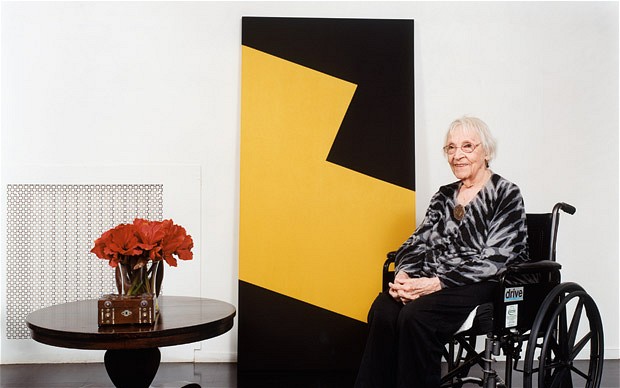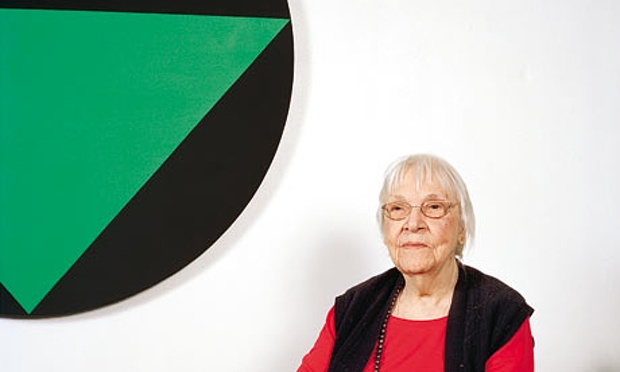The following article, written in first person by Chris Broughton at The Guardian in 2010, is about 100-year-old artist Carmen Herrera, who after a life spent painting, finally saw her abstract works purchased by a collector… at age 89. Her works now fetch up to USD$50,000 a piece.
In an interview with Art News in June 2015, Herrera said, “Don’t be intimidated by anything”.
2010: “Five years ago (age 94), some of my canvases were included in an exhibition in New York showcasing female geometric painters. There was an element of chance involved – a good friend put my name forward when one of the other artists dropped out. A collector bought five of my pieces, the first I had sold. I was 89 years old; I had been painting full-time for more than 60 years.
Over the decades I had occasional exhibitions and good reviews, but never sold a painting. The type of work I was doing simply wasn’t fashionable. There were knock-backs, too, such as a gallery owner who loved my work but wouldn’t show it, because I was a woman. Benign neglect, I call it – there was never any malice intended. I suppose I was a little bit ahead of my time and paid for it.
Perhaps if I’d been more aggressive things might have worked out differently, but for me, the work was everything. Recognition and money have never been an issue, painting is simply my vocation.
In 1939, when I met my husband in my native Cuba, I was studying architecture. I had done some sculpting, but after I married Jesse, an English professor, and moved with him to New York, my priorities shifted. I started training at New York’s Art Students League, but wasn’t satisfied. It was all so academic, and though I felt there was something I needed to express, I wasn’t finding a way to do it. It wasn’t until we spent some years living in Paris after the war that I made the discovery that was to change the course of my life.
Browsing through some bookstalls on the banks of the Seine, I came across something I simply hadn’t known existed. Every two years, Le Salon des Réalités Nouvelles had an exhibition of practically every geometric or minimalist artist in Europe. I opened a catalogue of one and was floored by some of the images I saw. I immediately knew this was the path I wanted to take.

I had to change my way of thinking and feeling about painting, and reject everything I’d been taught. I gave up representational art entirely and started working in the abstract. It was a struggle, but an interesting struggle. I worked very, very hard, and little by little, over many, many years, I came to find my own voice.
Jesse was endlessly supportive and one of the very few people who understood what I was aiming at. Poor man – I inflicted a lot of difficulties in his life. We had to move to neighbourhoods that were cheap but sometimes a little dangerous so I could have a big enough place to paint, and he did this with a lot of grace. I had a secure existence. We had no children, so once Jesse left for work in the morning I’d get any necessary housework out of the way and then paint for hours. Many talented people drop out of art because they can’t afford to do it, which is terribly sad. I was a very lucky woman. Even after Jesse died, in 2000, I carried on. I had no choice – my work really needed to come out, it was a necessity, as well as a pleasure.
After those first paintings were bought in 2004, word spread quickly and other pieces were sold. I was in shock for days. Now I have pieces in collections all over the world. Yet perhaps it’s been a good thing I was able to work for so many years without recognition. I was left alone to refine and distill my art for decades, paring things down to their essence. I have no regrets, no complaints, and my work is more important to me than ever. I’m not as well as I would like to be, but as soon as I begin painting all my aches and pains disappear.
I don’t know how I would have reacted if I had been more successful when I was young. Now it’s nice, and I have more money than I could ever have imagined earlier in my life. Yet I’m not overwhelmed by it at all. I’ve always been a private person, and my work is my private life – I’d resent it if I felt people were intruding when I was trying to paint. But it is very pleasant to be recognised a little bit – I’ve made it on to the cover of the New York Times without having to kill anyone. All I had to do was get old. The world came to me eventually – I just had to wait 94 years, that’s all.“
Image by Caroll Taveras.






















Add Comment